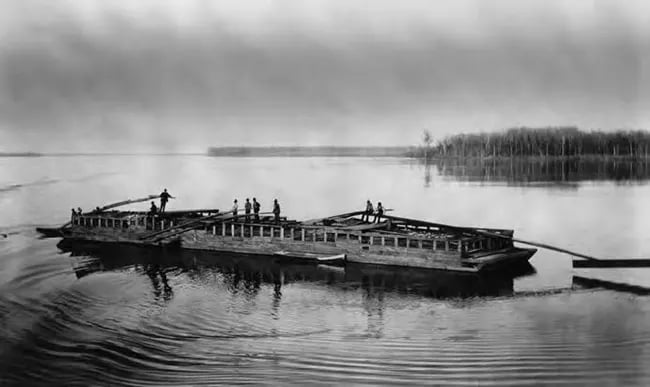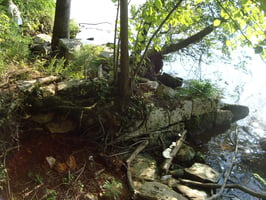Tuscumbia Landing: A Gateway to the West
Tennessee River: Canoes, Flatboats, Keelboats, & Steamships

From early Indian water navigation in canoes, to settlers traveling downriver in flatboats that carried their supplies, river transportation saw improvements as needs changed. Watercraft on the Tennessee River continuously improved up to the invention of steamboats, which opened up the cotton export to New Orleans and the world beyond. River navigation on the Tennessee, however, did not come without obstacles.
In order for a river to be considered navigable, there must be either actual, current navigation or a history of considerable use for transportation and trade. Any vessels that attempted to navigate the Tennessee River in its natural, unimproved condition found that they had to overcome many obstructions. There were numerous obstacles in the form of shoals, reefs, gravel and sand bars, ledges, and snags; swift currents which were caused by the slope and constrictions of the uncertain river channels. Prior to the 1820s, river transportation on the Tennessee River over the Muscle Shoals was confined to flatboats, keelboats, and other small craft such as canoes. After 1820, steamboat navigation opened up the Tennessee Valley’s cotton trade to major ports including New Orleans.
At least as early as 1690, the English had begun to trade furs with the Cherokee Indians in their settlements along the Tennessee River. The earliest written account of the Tennessee River and its Indian tribes came in 1701, when French-Canadian traders reported to the Louisiana Governor about a journey they made from Canada to South Carolina and back to the Mississippi River. By 1714, the French had built trading posts along the Tennessee River, and in about 1715, an Indian uprising in the Carolinas awakened the British to the importance of maintaining their trade at home.
Canoes
Native Americans were masters of river travel, and early settlers learned much from studying their vessels. Of the various Indian tribes the Cherokees most heavily utilized the Tennessee River as a means of transportation for their hunting expeditions as well as an avenue of warfare against the tribes north of the Ohio. In 1791, Henry Timberlake went down the Tennessee River by canoe for the purpose of gaining a thorough knowledge of the river’s navigation conditions. This knowledge would be useful in case of war with the Indians. Timberlake left an excellent description of the watercraft used by the Indians on the river:
“Their canoes are the next work of any consequence; they are generally made of a large pine or poplar, from 30 to 40 feet long, and about 2 broad, with flat bottoms and sides, and both ends alike; the Indians hollow them now with the tools they get from the Europeans, but formerly did it by fire: They are capable of carrying about 15 or 20 men, are very light, and can by the Indians, so great is their skill in managing them, be forced up a very strong current, particularly the bark canoes; but these are seldom used by the northern Indians.”
The French called this particular type of dugout canoe described by Timberlake a “pirogue” and the Spanish called it a “piragua”. Explorers and traders used it extensively on western rivers because it was not too heavy for portaging and was large enough to carry supplies when traveling light with no plans to settle.
Settlers could not travel in the same manner that hunters and traders traveled because settlers were burdened with household effects, cattle, farming implements and other necessities for starting a new life in a wilderness. Foot trails had to be widened into roads that could accommodate wagons, which was a long and tedious process. As settlers came upon the broader and less turbulent waters of the Tennessee River system, they envisioned the river’s usefulness in transporting their families and household goods.
The first requirement for the type of craft envisioned by the settlers was an ability to carry whole families and their effects downstream. They had no interest in developing a craft to go upstream. One variation of boat used by the settlers was to join two pirogues with planks that were fastened across them. This made a sizable raft that could travel with the river current and could be kept off the banks and rocks via the use of poles.
Flatboats
Perhaps the most useful of all the types of watercraft that the settlers developed, however, were the flatboats. At the end of the journey, these flatboats could be broken down into pieces and the lumber used to build the settlers first houses. As outlined in TVA’s A History of Navigation on the Tennessee River System, a flatboat like this would have cost between $1 to $1.25 per running foot. The boats were oblong, having boarded up sides and a roof that curved to provide shelter from the rain. These boats were 15 feet wide and from 20 to 25 feet long. The timbers of the bottom were intentionally massive to allow great strength capable of carrying heavy loads. These boats were often built with comfortable apartments. Flatboats were built to carry women, servants, cattle, horses, sheep, dogs, and poultry all under the same roof. Large “sweeps” or oars were used to help direct the course of the boats to keep them clear of rocks, snags.
Keelboats
With the development of local two-way trade came the necessity for some means of carrying products upstream. A partial answer to this need was found in keelboats, which began to appear on the Tennessee River at the turn of the nineteenth century. They were called keelboats because of the heavy four-inch keel timber that extended from the bow to the stern along the bottom of the boat. The keelboat was long and slender, pointed or rounded at bow and stern, and built on a heavy keel that was capable of withstanding the impact of collision with submerged rocks and logs. Keelboats were built to carry between ten and fifty tons. Planks attached along the gunwales provided a walkway which the crew crossed as they pushed long poles to navigate the boats against the river current. Keelboats required one man for every 3,000 pounds of freight carried, but so laborious was the work, that they had to rest once an hour. A trip between 14 to 30 miles a day was considered very good. The time and labor involved caused this method of transportation to be expensive. In spite of this expense, keelboats remained the best method for transporting freight upstream until the advent of the steamboat.
Steamboats
Increased access to the New Orleans market began when the first steamboat reached the Shoals. In 1822, the “Rocket” was commissioned to run regularly between Florence and the mouth of the Tennessee, there unloading its cargo to be transported to New Orleans or to the towns up the Ohio River on larger vessels. By 1825, regular lines were established to connect Tuscumbia with the cities on the Ohio River and New Orleans. Prior to 1830, there were “more than 20 magnificent steamers traveling between the cities at the Shoals, Cincinnati, and New Orleans.” As the number of steamboats increased, shipping rates fell.
By the year 1860, there were approximately fifty or more large steamers and many other smaller ones serving the Muscle Shoals area. Some of the largest of these steamships were “built with three decks and more than 250 feet long, carried 2,000 to 3,000 bales of cotton and other freight, in addition to 100 to 150 passengers.” Steamboats became a major player in every major transaction of the surrounding community of the Tennessee Valley.


